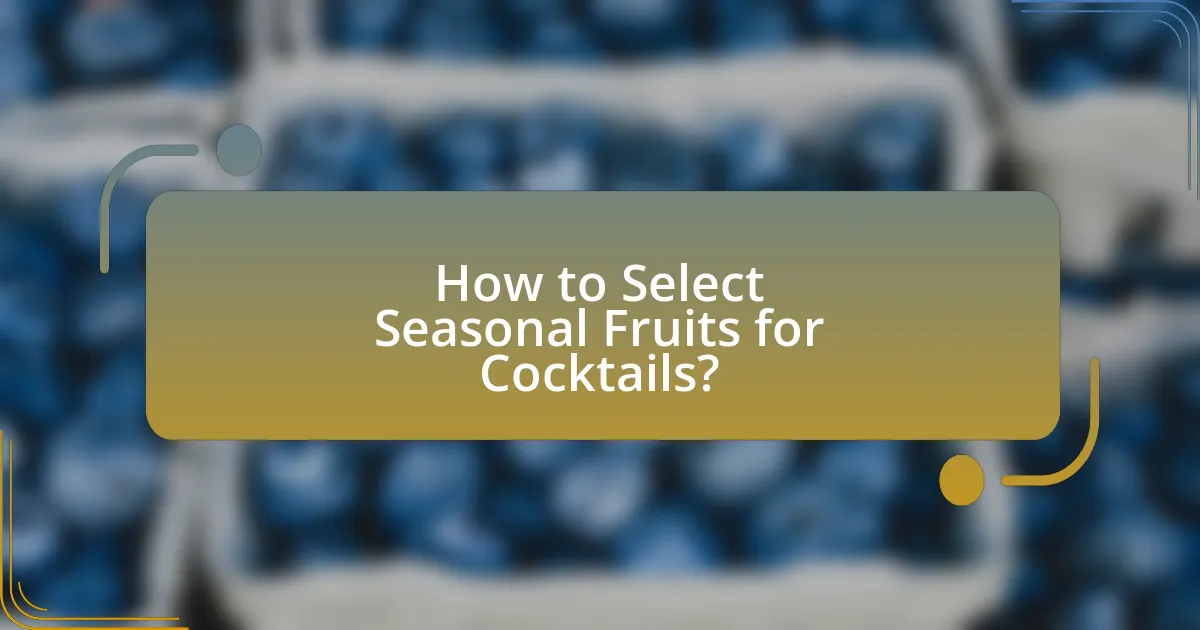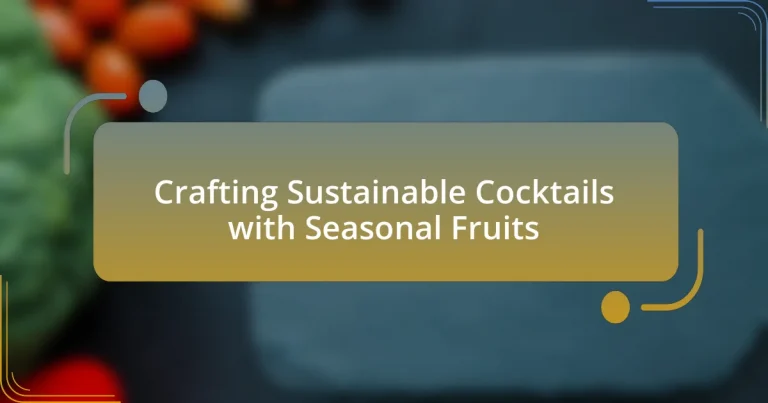Crafting sustainable cocktails with seasonal fruits focuses on creating eco-friendly beverages that utilize local, organic ingredients while minimizing waste. The article outlines the differences between sustainable and traditional cocktails, emphasizing the benefits of using seasonal fruits, such as enhanced flavor, support for local agriculture, and reduced carbon footprints. It discusses the environmental advantages of sourcing local produce, the impact on biodiversity, and best practices for selecting and preparing seasonal fruits. Additionally, innovative cocktail recipes and techniques for incorporating seasonal ingredients are provided, highlighting the importance of sustainability in the beverage industry.

What are Sustainable Cocktails and Why Use Seasonal Fruits?
Sustainable cocktails are beverages crafted using eco-friendly practices, emphasizing local, organic ingredients, and minimizing waste. The use of seasonal fruits in these cocktails enhances flavor, supports local agriculture, and reduces the carbon footprint associated with transporting out-of-season produce. Seasonal fruits are fresher and often more nutrient-dense, providing a superior taste experience while promoting sustainability in the beverage industry.
How do sustainable cocktails differ from traditional cocktails?
Sustainable cocktails differ from traditional cocktails primarily in their sourcing and environmental impact. Sustainable cocktails utilize locally sourced, organic, and seasonal ingredients, reducing carbon footprints associated with transportation and farming practices. For instance, using seasonal fruits not only enhances flavor but also supports local agriculture and minimizes the use of pesticides. In contrast, traditional cocktails often rely on mass-produced spirits and ingredients that may not prioritize environmental considerations. This shift towards sustainability is supported by a growing consumer demand for eco-friendly practices in the food and beverage industry, reflecting a broader trend towards responsible consumption.
What ingredients are typically used in sustainable cocktails?
Sustainable cocktails typically use organic spirits, locally sourced fruits, herbs, and natural sweeteners. Organic spirits reduce chemical exposure and support sustainable farming practices. Locally sourced fruits minimize transportation emissions and promote regional agriculture, while herbs add flavor and can often be grown in home gardens. Natural sweeteners, such as honey or agave syrup, provide alternatives to refined sugars, aligning with eco-friendly practices. These ingredients collectively contribute to a lower environmental impact and support local economies.
Why is the use of seasonal fruits important for sustainability?
The use of seasonal fruits is important for sustainability because it reduces the carbon footprint associated with transportation and storage. Seasonal fruits are typically grown locally, which minimizes the need for long-distance shipping that contributes to greenhouse gas emissions. Additionally, consuming fruits that are in season supports local farmers and promotes biodiversity by encouraging the cultivation of a variety of crops. Research indicates that local food systems can reduce energy consumption by up to 10 times compared to imported produce, highlighting the environmental benefits of choosing seasonal options.
What are the environmental benefits of crafting cocktails with seasonal fruits?
Crafting cocktails with seasonal fruits significantly reduces the carbon footprint associated with transportation and storage. Seasonal fruits are typically grown locally, minimizing the need for long-distance shipping, which contributes to greenhouse gas emissions. Additionally, using seasonal produce supports local agriculture, promoting biodiversity and reducing reliance on industrial farming practices that often harm the environment. According to the USDA, local food systems can reduce carbon emissions by up to 50% compared to conventional food supply chains. This practice also encourages sustainable farming methods, as local farmers are more likely to engage in environmentally friendly practices to meet community demand.
How does using local produce reduce carbon footprint?
Using local produce reduces carbon footprint by minimizing transportation emissions associated with food distribution. When fruits and vegetables are sourced from nearby farms, the distance they travel to reach consumers is significantly shorter, resulting in lower greenhouse gas emissions. For instance, a study by the USDA found that food transported over long distances can generate up to 11 times more carbon emissions compared to locally sourced food. Additionally, local farming practices often utilize fewer synthetic fertilizers and pesticides, which further decreases environmental impact. Thus, choosing local produce directly contributes to a reduction in overall carbon emissions.
What impact does seasonal fruit sourcing have on biodiversity?
Seasonal fruit sourcing positively impacts biodiversity by promoting the cultivation of diverse plant species and reducing reliance on monocultures. This practice encourages farmers to grow a variety of fruits that are native to their regions, which supports local ecosystems and wildlife. For instance, studies have shown that diverse agricultural systems can enhance soil health, increase resilience to pests, and improve pollinator populations, all of which are crucial for maintaining biodiversity. Additionally, sourcing fruits in season minimizes the carbon footprint associated with transportation and storage, further contributing to environmental sustainability.

How to Select Seasonal Fruits for Cocktails?
To select seasonal fruits for cocktails, prioritize fruits that are currently in season in your region, as they offer optimal flavor and freshness. Seasonal fruits vary by location and time of year; for example, strawberries and rhubarb are typically in season during spring, while apples and pears are harvested in the fall. Utilizing seasonal fruits not only enhances the taste of cocktails but also supports local agriculture and reduces carbon footprint associated with transportation. Research indicates that using in-season produce can improve the overall quality of beverages, as fruits are harvested at their peak ripeness, ensuring better flavor profiles and nutritional value.
What factors should be considered when choosing seasonal fruits?
When choosing seasonal fruits, factors such as freshness, flavor, nutritional value, and environmental impact should be considered. Freshness is crucial as seasonal fruits are harvested at their peak, ensuring optimal taste and texture. Flavor varies significantly with seasonality; fruits in season typically have a richer taste due to natural ripening processes. Nutritional value is often higher in seasonal fruits, as they are consumed closer to harvest, retaining more vitamins and minerals. Additionally, selecting seasonal fruits supports local agriculture and reduces carbon footprints associated with transportation, promoting sustainability in cocktail crafting.
How do climate and geography influence fruit availability?
Climate and geography significantly influence fruit availability by determining the growing conditions, such as temperature, rainfall, and soil type. For instance, tropical climates with consistent warmth and ample rainfall support the growth of fruits like bananas and mangoes year-round, while temperate regions experience seasonal variations that limit fruit availability to specific months, such as apples in autumn. Additionally, geographical factors like altitude and proximity to bodies of water can create microclimates that further affect which fruits can thrive in a given area. For example, vineyards in cooler regions often produce grapes that are suited for specific wine varieties, demonstrating how local climate and geography dictate the types of fruits that can be cultivated successfully.
What are the best practices for sourcing seasonal fruits?
The best practices for sourcing seasonal fruits include purchasing from local farmers, understanding peak harvest times, and prioritizing organic options. Local farmers often provide fresher produce, which is crucial for flavor and quality in cocktails. Knowing the peak harvest times for specific fruits ensures that you are selecting fruits at their ripest, enhancing the taste and nutritional value. Additionally, choosing organic fruits minimizes exposure to pesticides and supports sustainable farming practices, aligning with the principles of crafting sustainable cocktails.
Which seasonal fruits are best for cocktail crafting?
Seasonal fruits that are best for cocktail crafting include strawberries, peaches, and citrus fruits like oranges and lemons. Strawberries provide a sweet and vibrant flavor, making them ideal for refreshing summer cocktails. Peaches add a juicy and aromatic quality, perfect for creating fruity blends. Citrus fruits, such as oranges and lemons, offer acidity and brightness, enhancing the overall taste profile of cocktails. These fruits are not only flavorful but also widely available during their respective seasons, ensuring freshness and sustainability in cocktail preparation.
What are the flavor profiles of popular seasonal fruits?
Popular seasonal fruits exhibit diverse flavor profiles that enhance culinary experiences. For instance, strawberries, typically in season during late spring to early summer, are known for their sweet and slightly tart flavor, making them ideal for cocktails. Peaches, available in summer, offer a juicy sweetness with floral notes, perfect for refreshing drinks. Apples, harvested in fall, present a crisp and sweet flavor, with some varieties adding a tartness that complements various cocktail recipes. Citrus fruits like oranges and lemons, often in season during winter, provide bright acidity and refreshing zest, essential for balancing flavors in cocktails. Each of these fruits contributes unique taste characteristics that can elevate the quality and appeal of seasonal cocktails.
How can different fruits be paired for unique cocktail experiences?
Different fruits can be paired for unique cocktail experiences by combining complementary flavors and textures, enhancing the overall taste profile. For example, citrus fruits like lime and grapefruit can be paired with tropical fruits such as pineapple and mango to create a refreshing balance of acidity and sweetness. Additionally, berries like strawberries and blueberries can be mixed with herbs like mint or basil to introduce aromatic complexity. This approach is supported by the trend in mixology that emphasizes seasonal and local ingredients, which not only enhances flavor but also promotes sustainability in cocktail crafting.

What Techniques Can Be Used to Craft Sustainable Cocktails?
Techniques to craft sustainable cocktails include using seasonal fruits, minimizing waste, and sourcing local ingredients. Utilizing seasonal fruits ensures that the ingredients are fresh and have a lower carbon footprint due to reduced transportation needs. Minimizing waste can involve using fruit peels and scraps in syrups or garnishes, which not only enhances flavor but also reduces overall waste. Sourcing local ingredients supports local economies and decreases environmental impact, as local produce typically requires less energy for transportation. These practices collectively contribute to the sustainability of cocktail crafting.
How can seasonal fruits be incorporated into cocktail recipes?
Seasonal fruits can be incorporated into cocktail recipes by using them as fresh ingredients, purees, or garnishes. For instance, fruits like strawberries in spring or peaches in summer can be muddled into cocktails to enhance flavor and freshness. Additionally, seasonal fruits can be juiced or blended to create unique purees that serve as mixers, providing natural sweetness and vibrant color. Using fruits in their peak season ensures optimal flavor and supports local agriculture, making cocktails not only delicious but also sustainable.
What are some methods for preparing fruits for cocktails?
Some methods for preparing fruits for cocktails include slicing, muddling, juicing, and garnishing. Slicing fruits like citrus or berries enhances their visual appeal and allows for easy incorporation into drinks. Muddling, which involves crushing fruits to release their juices and flavors, is essential for cocktails like mojitos. Juicing fruits provides fresh, vibrant flavors that can be mixed into various cocktails, while garnishing with fruit slices or twists adds an aesthetic touch and enhances the overall drinking experience. These methods are widely used in cocktail preparation to maximize flavor and presentation.
How can seasonal fruits be preserved for longer use?
Seasonal fruits can be preserved for longer use through methods such as freezing, canning, drying, and making jams or jellies. Freezing retains the fruit’s nutrients and flavor, with studies showing that properly frozen fruits can last up to a year without significant loss of quality. Canning involves sealing fruits in jars and heating them to kill bacteria, allowing them to be stored for several years. Drying removes moisture, which inhibits spoilage, and dried fruits can last for months when stored in airtight containers. Making jams or jellies involves cooking fruits with sugar and pectin, which creates a shelf-stable product that can last for a year or more when sealed properly. These methods ensure that seasonal fruits remain available for use beyond their natural harvest period.
What are some innovative cocktail recipes using seasonal fruits?
Innovative cocktail recipes using seasonal fruits include a Peach Basil Smash, which combines fresh peaches, basil, gin, and lemon juice, creating a refreshing summer drink. Another example is the Spiced Pear Mule, made with pear puree, ginger beer, vodka, and a hint of cinnamon, perfect for autumn. Additionally, a Winter Citrus Spritz features blood oranges, grapefruit, prosecco, and rosemary, offering a vibrant winter option. These recipes utilize seasonal fruits to enhance flavor and sustainability, aligning with the trend of crafting cocktails that celebrate local and fresh ingredients.
How can classic cocktails be adapted with seasonal ingredients?
Classic cocktails can be adapted with seasonal ingredients by substituting traditional components with fresh, locally available fruits and herbs that reflect the current season. For example, a classic mojito can be enhanced by using fresh strawberries in spring or ripe peaches in summer instead of the usual lime, providing a unique flavor profile while promoting sustainability. This approach not only supports local agriculture but also reduces the carbon footprint associated with transporting out-of-season ingredients. Seasonal adaptations can elevate the cocktail experience, making it more relevant and enjoyable for consumers.
What are some unique cocktail ideas for different seasons?
Unique cocktail ideas for different seasons include a refreshing cucumber mint cooler for summer, a spiced apple cider cocktail for fall, a citrusy blood orange spritz for winter, and a floral elderflower gin fizz for spring. Each cocktail utilizes seasonal ingredients, enhancing flavor and sustainability. For example, the cucumber mint cooler features fresh cucumbers and mint, which are abundant in summer, while the spiced apple cider cocktail incorporates locally sourced apples and spices, reflecting fall’s harvest. This approach not only promotes the use of seasonal fruits but also supports local agriculture and reduces carbon footprint associated with transporting out-of-season ingredients.
What are the best practices for serving sustainable cocktails?
The best practices for serving sustainable cocktails include using locally sourced ingredients, minimizing waste, and selecting organic or sustainably produced spirits. Locally sourced ingredients reduce carbon footprints associated with transportation and support local economies. Minimizing waste can be achieved by utilizing all parts of fruits and vegetables, such as using peels for garnishes or infusions. Additionally, choosing organic or sustainably produced spirits ensures that the production methods are environmentally friendly, as these products often adhere to stricter agricultural practices that protect ecosystems. These practices contribute to a more sustainable cocktail culture while enhancing flavor and quality.
How can presentation enhance the appeal of sustainable cocktails?
Presentation enhances the appeal of sustainable cocktails by creating a visually striking experience that attracts consumers and emphasizes the cocktail’s eco-friendly ingredients. A well-presented cocktail can highlight the vibrant colors of seasonal fruits, making the drink more enticing and encouraging customers to choose sustainable options. Research indicates that visual appeal significantly influences consumer choices, with studies showing that 93% of consumers prioritize visual appearance when making food and beverage decisions. Therefore, incorporating elements like unique glassware, garnishes from local produce, and artistic arrangements can elevate the perception of sustainability in cocktails, ultimately driving interest and sales.
What tips can ensure a sustainable cocktail experience for guests?
To ensure a sustainable cocktail experience for guests, utilize seasonal fruits and local ingredients. Seasonal fruits reduce carbon footprints by minimizing transportation emissions and supporting local agriculture. For example, using fruits like strawberries in summer or apples in fall aligns with their natural growing seasons, enhancing flavor and freshness. Additionally, implementing practices such as composting organic waste and using biodegradable straws further promotes sustainability in cocktail service. These strategies not only create a positive environmental impact but also resonate with eco-conscious consumers, enhancing their overall experience.


